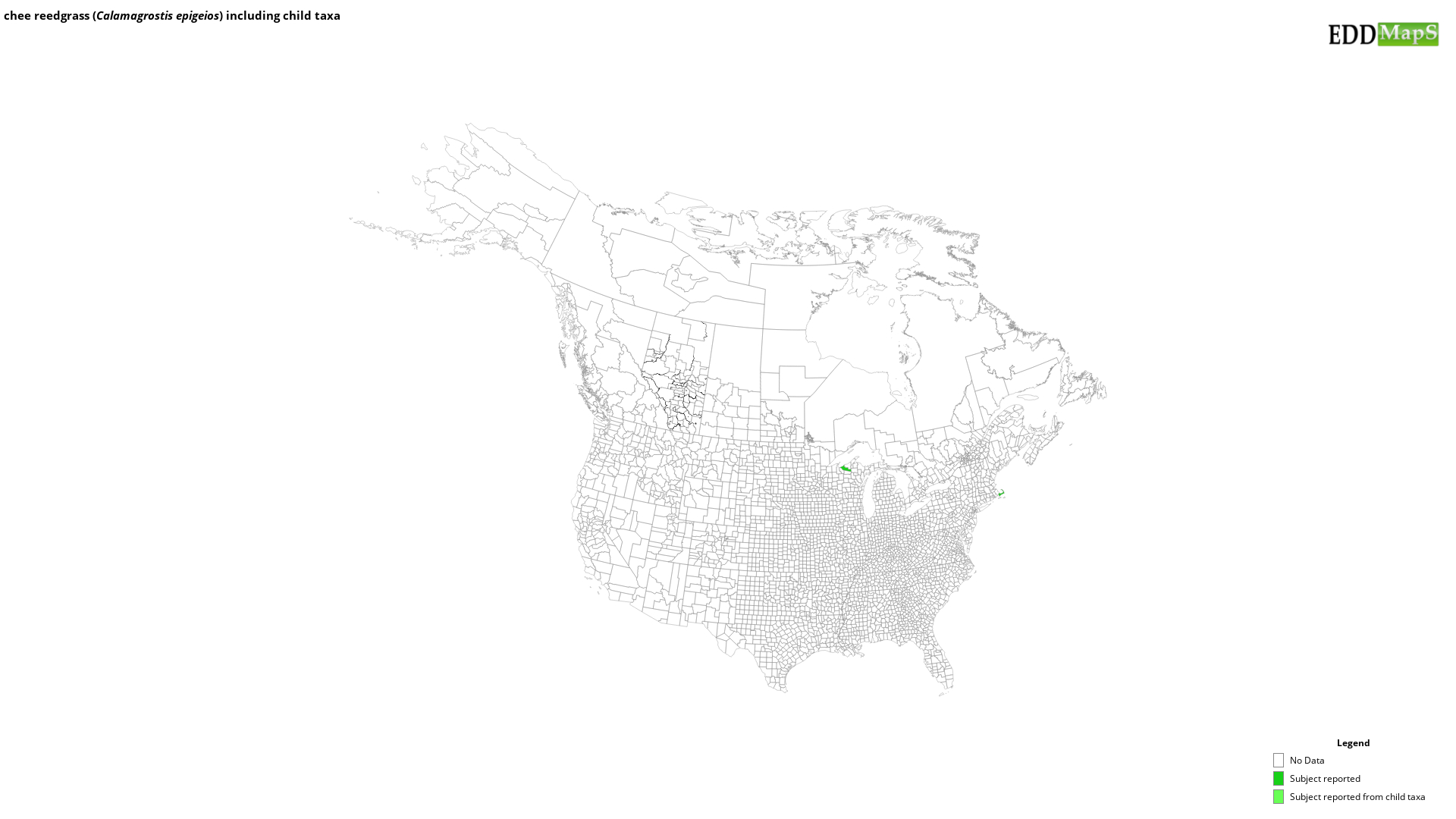chee reedgrass
(Calamagrostis epigeios)
This species is Introduced in the United States
ORIGIN: Africa, Asia, Europe
GROWTH TRAITS: Perennial grass with flowering stems reaching 2-6.5' (60- 200 cm) tall from a rhizomatous root system. Stems are hollow between nodes. Leaf-blades are alternate, drooping, up to 28" (70 cm) long by 0.5" (12 mm) wide, green, with ribbed and rough upper surfaces. On the interior surface of the leaf where it meets the stem is a papery, triangular ligule 0.16-0.5" (4–12 mm) long. Florets occur on dense, branched inflorescences 6-12" (15-30 cm) long throughout summer. At maturity, inflorescences are a rich brown or tinged with purple. Each floret is enclosed by 2 narrow, pointed bracts 0.2-0.28" (5-7 mm) long. These gape open to reveal 2 narrow shorter bracts, the reproductive parts, and a mass of fine, white hairs. New stems sprout from rhizomes in spring.
REPRODUCTION: Spreads by seed and rhizomes. Seeds remain viable in the soil for at least five years.
HABITAT: Can tolerate a wide variety of conditions including moist, brackish soil and dry conditions. It can be found escaping cultivation along fields, roadsides, and other disturbed places and also invading meadows and forest clearings.
LOOK-ALIKES: Native bluejoint (Calamagrostis canadensis) is very similar to chee reedgrass, but it grows somewhat shorter with a smaller, narrower, less-dense inflorescence and narrower leaves. The ligule of bluejoint is also shorter (up to 0.16" or 4 mm long) and more flat at its tip. The native slimstem reedgrass (C. stricta) is also very similar but has even smaller features than bluejoint. Slimstem reedgrass is also typically a wetland species.
CITATIONS:
Rawlins, K.A., R.L. Winston, C.T. Bargeron, D.J. Moorhead, and R. Carroll. 2018. New Invaders of the Northeast and Northcentral United States. USDA Forest Service, Forest Health Assessment and Applied Sciences Team, Morgantown, West Virginia. FHTET-2017-04. Retrieved from https://bugwoodcloud.org/resource/pdf/FHTET-2017-04_New%20Invaders_NE.pdf
GROWTH TRAITS: Perennial grass with flowering stems reaching 2-6.5' (60- 200 cm) tall from a rhizomatous root system. Stems are hollow between nodes. Leaf-blades are alternate, drooping, up to 28" (70 cm) long by 0.5" (12 mm) wide, green, with ribbed and rough upper surfaces. On the interior surface of the leaf where it meets the stem is a papery, triangular ligule 0.16-0.5" (4–12 mm) long. Florets occur on dense, branched inflorescences 6-12" (15-30 cm) long throughout summer. At maturity, inflorescences are a rich brown or tinged with purple. Each floret is enclosed by 2 narrow, pointed bracts 0.2-0.28" (5-7 mm) long. These gape open to reveal 2 narrow shorter bracts, the reproductive parts, and a mass of fine, white hairs. New stems sprout from rhizomes in spring.
REPRODUCTION: Spreads by seed and rhizomes. Seeds remain viable in the soil for at least five years.
HABITAT: Can tolerate a wide variety of conditions including moist, brackish soil and dry conditions. It can be found escaping cultivation along fields, roadsides, and other disturbed places and also invading meadows and forest clearings.
LOOK-ALIKES: Native bluejoint (Calamagrostis canadensis) is very similar to chee reedgrass, but it grows somewhat shorter with a smaller, narrower, less-dense inflorescence and narrower leaves. The ligule of bluejoint is also shorter (up to 0.16" or 4 mm long) and more flat at its tip. The native slimstem reedgrass (C. stricta) is also very similar but has even smaller features than bluejoint. Slimstem reedgrass is also typically a wetland species.
CITATIONS:
Rawlins, K.A., R.L. Winston, C.T. Bargeron, D.J. Moorhead, and R. Carroll. 2018. New Invaders of the Northeast and Northcentral United States. USDA Forest Service, Forest Health Assessment and Applied Sciences Team, Morgantown, West Virginia. FHTET-2017-04. Retrieved from https://bugwoodcloud.org/resource/pdf/FHTET-2017-04_New%20Invaders_NE.pdf
Maps
EDDMapS Distribution - This map is incomplete and is based only on current site and county level reports made by experts, herbaria, and literature. For more information, visit www.eddmaps.org
Taxonomic Rank
| Domain: Eukarya |
| Kingdom: Plantae |
| Phylum: Magnoliophyta |
| Class: Magnoliopsida |
| Superorder: Lilianae |
| Order: Poales |
| Family: Poaceae |
| Subfamily: Pooideae |
| Tribe: Poeae |
| Genus: Calamagrostis |
| Calamagrostis epigeios |
References
Common Name Reference: USDA, NRCS. 2010. The PLANTS Database. National Plant Data Center, Baton Rouge, LA, USA.
Scientific Name Reference: USDA, NRCS. 2010. The PLANTS Database. National Plant Data Center, Baton Rouge, LA, USA.

